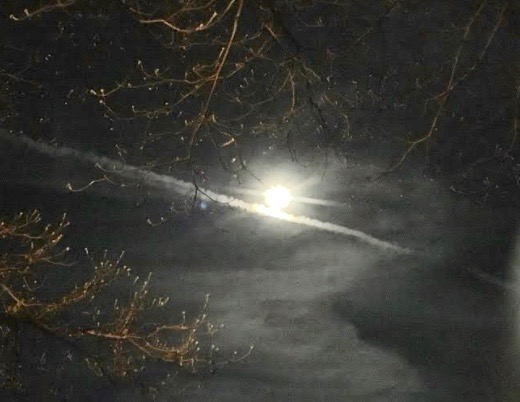A moon for the ages
‘It’s a lunar eclipse, a super moon, and a blue moon all at once, which is pretty unusual’

Gazebo Photo by Gazebo Staff Photo
A jet stream appears across the bottom of the full moon in Macon at 9 p.m. Tuesday night
Early Wednesday morning, if you look at the sky, you will be able to see quite a phenomenon.
However, you will have to be up pretty early to be able to see it clearly.
The celestial event is known as a “blue moon” or “blood moon” and occurs as the moon slides behind Earth’s shadow during a lunar eclipse. It is the first blue moon total lunar eclipse in the world in more than 150 years.
“This one is special because it’s a lunar eclipse, a super moon, and a blue moon all at once, which is pretty unusual,” science teacher Mrs. Susan Hanberry said.
“I heard about the eclipse a couple of days ago and it seems pretty interesting for all these conditions to happen at the same time,” sophomore Daniel Smolensky said.
Unlike last summer’s solar eclipse — where the moon momentarily blocked out the sun — a lunar eclipse is when Earth moves in between the sun and the moon. Lunar eclipses themselves are not uncommon, but the coincidence of Wednesday’s blood moon with other astronomical events is what makes this event special.
First, because it is a “blue moon” — that means it is the second full moon to occur in a month. Also, it is a supermoon, meaning it will be closer to Earth than usual, though the difference in size is hardly noticeable.
For people living on the East Coast, the moon will begin entering the penumbra (the outer, lighter part of Earth’s shadow) at 5:51 a.m. Then it will plunge into the umbra (the darker portion of Earth’s shadow that creates the reddish glow) at 6:48 a.m.
“I don’t know much about lunar eclipses, but this one should be pretty cool,” sophomore Thomas Sachy said. “I’m probably going to sleep through it, though.”

Zeraiz Shabbir is a sophomore and in his first year on the staff of The Gazebo. His favorite subjects are Accelerated Chemistry and AP World History. His...


